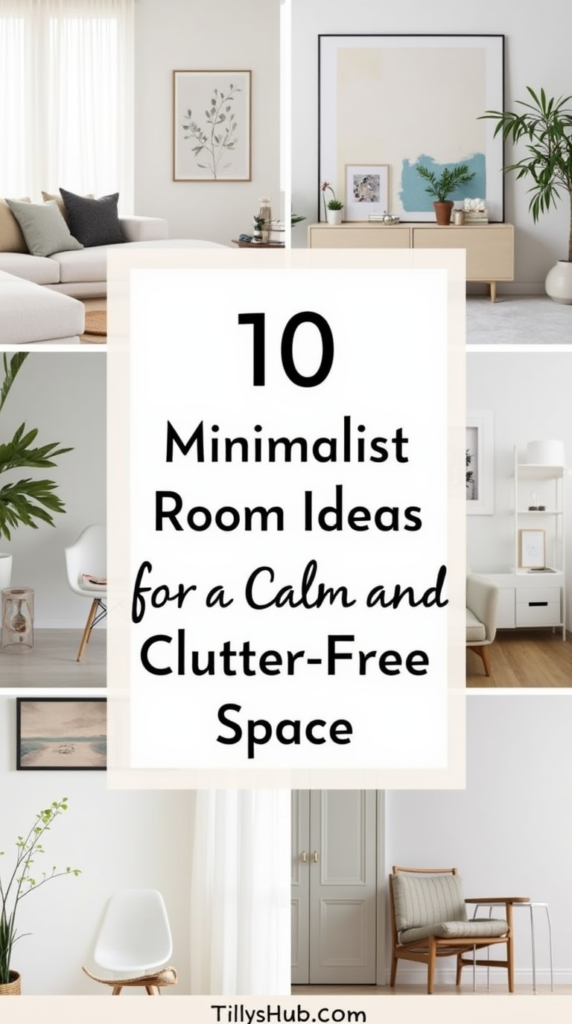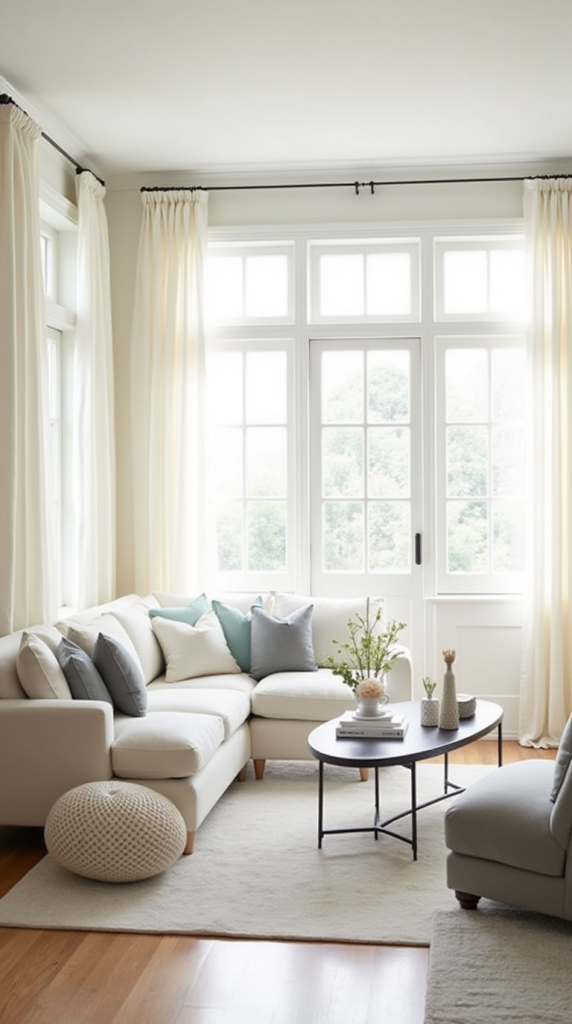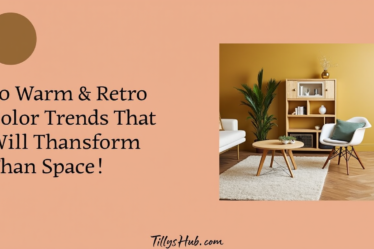
Hey there, my fellow home decor enthusiasts! 🏡 Can you believe we’re already talking about minimalist room ideas? I don’t know about you, but I’ve been craving a little more zen in my life after the craziness of the past few years.
You know, I used to be the queen of clutter – my place was like a treasure trove of knick-knacks and tchotchkes. But then I started feeling so overwhelmed by all the stuff, and it was really impacting my mental health. That’s when I decided it was time for a minimalist makeover.
Well, let me tell you, decluttering and streamlining my space has been an absolute game-changer.
I feel so much more calm and focused, and I actually look forward to spending time in my little minimalist oasis. And today, I can’t wait to share my top 10 tips to help you create your own serene, clutter-free haven!
(Before you move on, don’t forget to SAVE THIS PIN so you can come back to it again later!)
1. Embrace Natural Light
Picture this: An airy, sun-drenched living room with clean lines and soothing neutral tones. I started by clearing out all the heavy curtains and letting that beautiful natural light pour in. It’s amazing how much brighter and more open the space feels now. Plus, those sheer curtain panels just add the perfect delicate touch, don’t they?
How to do it:
- Ditch the dark, heavy curtains
- Opt for sheer, billowy panels that filter the light
- Position furniture to maximize window exposure
- Consider adding a skylight or two for even more brightness
2. Curate Your Furniture
I’ll be honest, downsizing my furniture was one of the hardest parts of this minimalist journey. But once I did it, I was kicking myself for not doing it sooner! Now, every piece in my home has a purpose and a place. No more side tables collecting dust or that bulky entertainment center crowding the room.
Here’s how I did it:
- Choose versatile, multi-purpose furniture
- Avoid overcrowding – leave plenty of breathing room
- Invest in quality pieces that will stand the test of time
- Be ruthless when editing – if it doesn’t earn its keep, it’s gotta go!
3. Opt for Monochrome Palettes
You know me, I’ve always been a sucker for color. But when I started down this minimalist path, I realized that soothing, monochromatic palettes were the way to go. Seriously, something about those soft grays and creamy whites just instantly calms my mind. And can we talk about how amazing texture is for adding visual interest?
How to make it work:
- Stick to a cohesive color scheme, like all-white or earthy neutrals
- Incorporate different textures, like linen, wood, and stone
- Let your decor seamlessly blend into the background
- Use pops of color sparingly as accents
4. Display Thoughtful Accents
Picture this: A clean, white shelf with just three carefully chosen items—a hand-carved wooden bowl, a simple framed photo, and a sleek ceramic vase. The space feels serene yet personal, with every piece adding meaning without overwhelming the design.
Minimalism doesn’t mean you have to strip your space of all personality—far from it! In fact, displaying a few meaningful, well-curated accents can actually enhance the serene vibe of your room. For me, this meant keeping only a handful of my most cherished pieces: a handmade ceramic vase, a framed photo of my family, and a sleek candleholder. These little touches make my space feel personal without overwhelming it.
How to keep it thoughtful:
- Choose 3-5 decorative items that truly speak to you.
- Stick to a theme, whether it’s neutral tones, natural materials, or a cohesive shape.
- Avoid cluttering surfaces—less is more!
- Rotate items seasonally to keep your space feeling fresh and intentional.
5. Declutter Your Walls
Picture this: A calming bedroom with crisp white walls, a single oversized abstract painting above the bed, and nothing else cluttering the visual field. The simplicity makes the space feel expansive and peaceful.
I used to love filling every inch of wall space with art, photos, and mirrors, but wow, did it feel busy! Now, I’m all about the “less is more” mindset for my walls. A single statement piece or a clean gallery arrangement works wonders for maintaining a minimalist aesthetic.
How to simplify your walls:
- Take down everything and start fresh.
- Pick one or two larger pieces instead of multiple small ones.
- Opt for frames that match your room’s palette.
- Embrace empty wall space—it’s not wasted; it’s restful!
6. Prioritize Storage Solutions
Picture this: A cozy living room with a modern coffee table that lifts to reveal hidden storage, and a sleek TV stand with closed compartments. Every surface is free of clutter, giving the space an effortless, tidy look.
Here’s a hot tip: hidden storage is your best friend when you’re going minimalist. My coffee table now has a lift-up top for stashing remotes and books, and I swapped out open shelving for sleek cabinets. The result? A space that feels clean and calm, even when life gets messy.
Storage strategies to try:
- Invest in furniture with built-in storage, like ottomans or benches.
- Use baskets or bins in neutral tones to organize clutter.
- Keep surfaces clear by designating a “home” for every item.
- Declutter regularly to prevent accumulation.
7. Keep Greenery Simple
Picture this: A bright dining area with a single large fiddle-leaf fig in a matte black pot in the corner and a small cluster of succulents in neutral planters as a centerpiece. It’s a subtle yet lively touch that breathes life into the room.
I love plants as much as the next person (hello, plant parent life 🌿), but in a minimalist space, it’s all about quality over quantity. A single fiddle-leaf fig or a trio of succulents can add that perfect touch of life and color without feeling overbearing.
How to go green, the minimalist way:
- Stick to 1-3 plants per room.
- Choose low-maintenance greenery, like snake plants or pothos.
- Use simple, neutral planters to keep the look cohesive.
- Position plants where they can thrive naturally, like near windows.
8. Create Zones for Functionality
Picture this: A small studio apartment with an area rug defining the living space, a wall-mounted desk in the corner creating a work zone, and a cozy sleeping nook separated by a lightweight curtain. Each zone feels distinct and intentional.
In minimalist spaces, defining distinct zones can help maximize both functionality and flow. My studio apartment, for example, went from chaotic to harmonious when I used area rugs and furniture placement to carve out separate areas for sleeping, working, and lounging.
Steps to create zones:
- Use rugs, lighting, or furniture to visually separate spaces.
- Keep each zone simple—don’t overcrowd with furniture or decor.
- Maintain a consistent design style throughout for a cohesive feel.
- Make each area serve a clear purpose.
9. Invest in Quality Over Quantity
Picture this: A beautiful dining room with a solid oak table, paired with simple yet elegant chairs and a single pendant light overhead. Every item feels purposeful and built to last.
When I adopted minimalism, I realized that I was better off with fewer, high-quality items than a houseful of cheap, disposable ones. Now, every item in my home feels intentional and built to last.
How to choose quality over quantity:
- Spend more on timeless staples (like a solid wood table or a comfy sofa).
- Avoid trends and focus on pieces that suit your personal style.
- Maintain and care for your items to make them last longer.
- Let go of the mindset that you need “more” to feel fulfilled.
10. Let Go of Sentimental Clutter
Picture this: A neat closet with only a few favorite items hanging, a single keepsake box on the shelf, and plenty of empty space to breathe. Letting go of sentimental clutter doesn’t mean letting go of memories—it means cherishing only the most meaningful ones.
Phew, this one was tough for me, y’all. I’m such a sentimental hoarder—I had stuff packed away that I hadn’t even looked at in years! But you know what they say, if it doesn’t spark joy, it’s gotta go. I know it can be hard, but trust me, once you start editing down and only keeping the things that truly matter, it’s like a weight has been lifted.
My top tips for decluttering:
- Go through each item and ask yourself, “Does this bring me happiness or serve a purpose?”
- Be honest with yourself—if you haven’t used it in the last year, you probably don’t need it.
- Donate, recycle, or sell anything that doesn’t make the cut.
- Remember, your space (and mental health!) will thank you in the end.
Here’s to finding your zen and embracing a simpler, more intentional way of living. Happy decorating! ✨
11. Let Go of Sentimental Clutter
Phew, this one was tough for me, y’all. I’m such a sentimental hoarder – I had stuff packed away that I hadn’t even looked at in years! But you know what they say, if it doesn’t spark joy, it’s gotta go. I know it can be hard, but trust me, once you start editing down and only keeping the things that truly matter, it’s like a weight has been lifted.
My top tips for decluttering:
- Go through each item and ask yourself, “Does this bring me happiness or serve a purpose?”
- Be honest with yourself – if you haven’t used it in the last year, you probably don’t need it
- Donate, recycle, or sell anything that doesn’t make the cut
- Remember, your space (and mental health!) will thank you in the end
Whew, that’s a lot of minimalist magic, am I right? I know it can feel like a big undertaking, but trust me, it’s so worth it. Just take it one step at a time, and before you know it, you’ll be living in your own serene, clutter-free oasis.
Let me know which of these ideas you’re most excited to try – I’d love to hear all about your minimalist makeover journey! And as always, if you need any help along the way, you know I’m just a message away. Happy decorating, my friends! 💛




